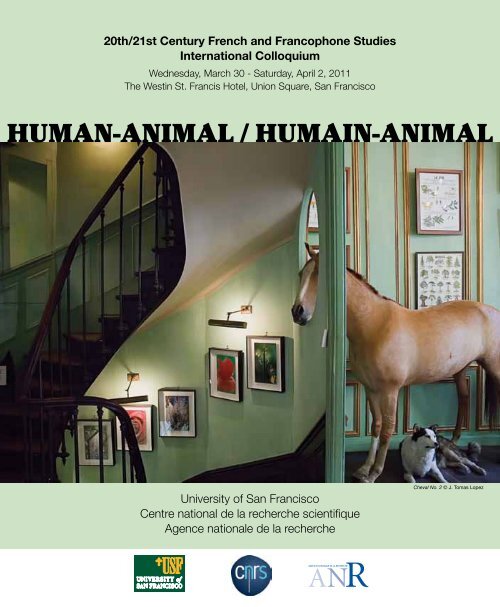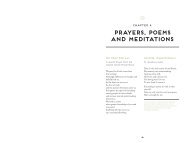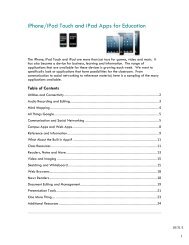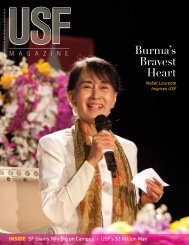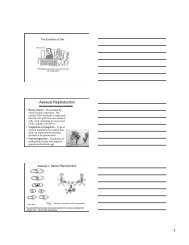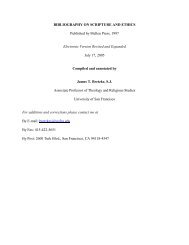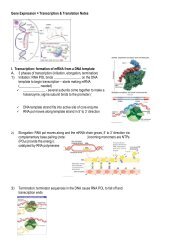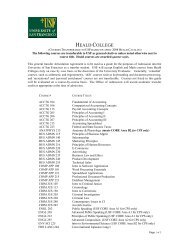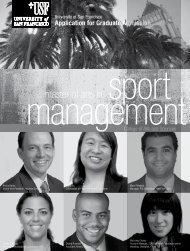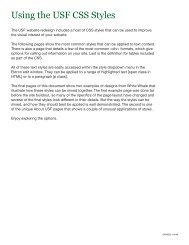HUMAN-ANIMAL / HUMAIN-ANIMAL - University of San Francisco
HUMAN-ANIMAL / HUMAIN-ANIMAL - University of San Francisco
HUMAN-ANIMAL / HUMAIN-ANIMAL - University of San Francisco
Create successful ePaper yourself
Turn your PDF publications into a flip-book with our unique Google optimized e-Paper software.
20th/21st Century French and Francophone Studies<br />
International Colloquium<br />
Wednesday, March 30 - Saturday, April 2, 2011<br />
The Westin St. Francis Hotel, Union Square, <strong>San</strong> <strong>Francisco</strong><br />
<strong>HUMAN</strong>-<strong>ANIMAL</strong> / <strong>HUMAIN</strong>-<strong>ANIMAL</strong><br />
<strong>University</strong> <strong>of</strong> <strong>San</strong> <strong>Francisco</strong><br />
Centre national de la recherche scientifique<br />
Agence nationale de la recherche<br />
Cheval No. 2 © J. Tomas Lopez<br />
A
B<br />
Acknowledgements<br />
The “Human-Animal” Colloquium is sponsored by the College <strong>of</strong> Arts and Sciences <strong>of</strong> the <strong>University</strong> <strong>of</strong> <strong>San</strong> <strong>Francisco</strong>,<br />
the French National Research Agency (ANR – Project “Animots: Animals and Animality in 20th-21st Century French and<br />
Francophone Literature”), the Arts and Language Research Center (CRAL, the CNRS / EHESS), the <strong>University</strong> Sorbonne<br />
Nouvelle-Paris 3 (Team “Writings <strong>of</strong> Modernity”), and The French Consulate <strong>of</strong> <strong>San</strong> <strong>Francisco</strong>.<br />
Remerciements<br />
Le colloque « Humain-Animal » a reçu le soutien de la Faculté de Lettres et Sciences de l’Université de <strong>San</strong> <strong>Francisco</strong>, de<br />
l’Agence nationale de la recherche (ANR – Programme « Animots : animaux et animalité dans la littérature de langue<br />
française XXe-XXIe siècles »), du Centre de recherches sur les arts et le langage (CRAL, CNRS / EHESS), de l’Université<br />
Sorbonne Nouvelle-Paris 3 (Équipe « Écritures de la modernité ») et du Consulat Général de France à <strong>San</strong> <strong>Francisco</strong>.<br />
With special thanks to Audrey Lasserre for her tremendous work <strong>of</strong> organization and on the progam schedule; Dr. Lois<br />
Lorentzen, Associate Dean, and Dr. Marcelo Camperi, Dean <strong>of</strong> the College <strong>of</strong> Arts and Sciences for their generous<br />
contribution and continuing support; John Pinelli, Executive Director <strong>of</strong> the College <strong>of</strong> Arts and Sciences; Teresa Zane,<br />
Assistant Director <strong>of</strong> Financial Applications for her skills in computer technology; USF Office <strong>of</strong> Publications for their<br />
collaboration with the production <strong>of</strong> the program; Jennesis K. Jensen, program assistant <strong>of</strong> the Department <strong>of</strong><br />
Languages for her precious help, and all the students who contributed to the realization <strong>of</strong> this colloquium.<br />
Finally, we thank J. Tomas Lopez who generously gave us permission to reproduce the photograph Cheval No.2.<br />
En remerciant tout particulièrement Audrey Lasserre, pour son immense travail de programmation et d’organisation ;<br />
Dr. Lois Lorentzen, Doyenne associée, et Dr. Marcelo Camperi, Doyen de la Faculté de Lettres et Sciences, pour leur<br />
généreuse contribution et leur soutien constant ; John Pinelli, Directeur administratif de la Faculté de Lettres et Sciences ;<br />
Teresa Zane, Directrice adjointe des Services financiers pour ses talents en informatique ; le Service Publications pour<br />
sa collaboration à l’édition du programme ; Jennesis K. Jensen, assistante du Département de Langues, pour son aide<br />
précieuse, ainsi que l’ensemble des étudiants ayant contribué à la réalisation de ce colloque.<br />
Enfin, nous remercions J. Tomas Lopez de nous avoir généreusement autorisées à reproduire la photographie<br />
Cheval No.2.<br />
Conference Organizers / Organisatrices<br />
Anne Mairesse <strong>University</strong> <strong>of</strong> <strong>San</strong> <strong>Francisco</strong><br />
Anne Simon Centre national de la recherche scientifique (CNRS)<br />
Agence nationale de la recherche (ANR)<br />
Conference Administrator / Coordinatrice<br />
Audrey Lasserre (ANR / EHESS)<br />
www.usfca.edu/humananimal/
20th/21st Century French and Francophone Studies<br />
International Colloquium<br />
Wednesday, March 30 – Saturday, April 2, 2011<br />
The Westin St. Francis Hotel, Union Square, <strong>San</strong> <strong>Francisco</strong><br />
<strong>HUMAN</strong>-<strong>ANIMAL</strong> / <strong>HUMAIN</strong>-<strong>ANIMAL</strong><br />
Plenary Speakers / Conférenciers en sessions plénières<br />
Jean-Christophe BAILLY<br />
écrivain École nationale supérieure de la nature et du paysage de Blois<br />
Raymond BELLOUR<br />
écrivain, spécialiste d’études filmiques Centre national de la recherche scientifique<br />
Special Sessions / Sessions spéciales avec<br />
Luc LANG<br />
romancier École nationale supérieure d’arts de Paris-Cergy<br />
J. Tomas LOPEZ<br />
photographe Université de Miami<br />
Xabi MOLIA<br />
écrivain, scénariste et réalisateur Université de Poitiers<br />
Patrice NGANANG<br />
écrivain Université de Stony Brook, NY<br />
1
Wednesday March 30<br />
2<br />
PROGRAM / PROGRAMME<br />
Details are subject to change / Sous réserve de modifications<br />
12:30–5:00pm Registration / Accueil des participant.e.s — Book Exhibit / Expo-Livres California East<br />
2:00–3:30pm PANELS ROOM<br />
1A BÊtES À ABAttRE Yorkshire<br />
Chair: Vincent Bruyere, Pennsylvania State <strong>University</strong><br />
• Isabelle Beucher, Lycée Paul Eluard de Saint-Denis / Université Paris Ouest-Nanterre, Image de l’abattoir,<br />
du comestible, et marchandisation du corps humain dans la mise en scène contemporaine<br />
• Vincent Bruyere, Pennsylvania State <strong>University</strong>, Of Belugas, Moose and Men: Sense <strong>of</strong> Community<br />
and Sense <strong>of</strong> Animality in Pierre Perrault’s Cinema<br />
• Kathryn Rose, Harvard <strong>University</strong>, Plotting the animal in Modiano’s Des inconnues<br />
1B BÊtES dE SCÈNE Et d’ÉCRAN Hampton<br />
Chair: Charles R. Batson, Union College<br />
• Alison J. Murray Levine, <strong>University</strong> <strong>of</strong> Virginia, Deterritorializing Cinema: The Films <strong>of</strong> Abderrahmane Sissako<br />
• Charles R. Batson, Union College, “Bêtes de scène”: Robert Lepage’s Totem, Circus, and the Freakish<br />
Human Animal<br />
• Sébastien Bouchard, Université Laval, Québec / Université de Rouen, Le mythe de l’homme civilisé dans le<br />
théâtre de Bernard-Marie Koltès<br />
1C dISLOCAtION, dISSECtION, dÉCOUPAGE dU SUjEt-<strong>ANIMAL</strong> Kent<br />
Chair: Laura Asok, <strong>University</strong> <strong>of</strong> Southern California<br />
• Fanny Mahy, <strong>University</strong> <strong>of</strong> Western Ontario, Canada / Université Charles de Gaulle - Lille 3, Faits divers<br />
monstrueux et monstrueuses figures du fait divers : La Classe de neige d’Emmanuel Carrère et Les<br />
Jouets vivants de Jean-Yves Cendrey<br />
• Maxime Philippe, Université McGill, Canada, Le devenir-animal d’Artaud : Hoc est enim Corpus meum<br />
• Laura Asok, <strong>University</strong> <strong>of</strong> Southern California, Artaud’s Butcher: Assembling the Animal Subject<br />
1d CONNAÎtRE L’<strong>HUMAIN</strong> PAR L’<strong>ANIMAL</strong> Cambridge<br />
Chair: Philippe Chardin, Université François-Rabelais de Tours<br />
• Nicolas Delon, Université de Picardie Jules Verne, CURAPP, Biographie animale et empathie : connaître et<br />
respecter la vie des animaux<br />
• Thérèse Gagnon, Université Carleton, Ottawa, La relation humain-animal selon Marguerite Yourcenar<br />
• Zishad Lak, Université Laval, Raconter, c’est humain : narration et métamorphose animale dans Truismes de<br />
Marie Darrieussecq<br />
3:30–4:00pm mid-afternoon tea break and snacks California East
Wednesday March 30<br />
4:00–5:30pm PANELS ROOM<br />
2A LES BÊtES EN BANdES dESSINÉES Victorian<br />
Chair: Anouk Alquier, Smith College<br />
• Aparna Nayak-Guercio, California State <strong>University</strong>, Long Beach, La liberté guidant les animaux : Calvo’s<br />
reinterpretation <strong>of</strong> Delacroix<br />
• Patrice Leche, Lyon, De la relation entre le personnage et l’animal : étude de quelques personnages<br />
issus du folklore des comics américains<br />
• Anouk Alquier, Smith College, Adèle et ses bêtes<br />
2B INGEStIONS Et HYBRIdAtIONS (dESBIOLLES, NdIAYE, NIMIER) Yorkshire<br />
Chair: Anne Martine Parent, Université du Québec à Chicoutimi<br />
• Philippe C. Dubois, Bucknell <strong>University</strong>, L’animal en nous : mastiquer la mort ou digérer l’ingérable<br />
• Aïcha Ennaciri, <strong>University</strong> <strong>of</strong> Colorado, Boulder, Dissonante hybridité ou la femme-animal chez Marie<br />
NDiaye<br />
• Carol J. Murphy, The <strong>University</strong> <strong>of</strong> Florida, Marie Nimier au zoo : animalité abjecte dans La Girafe<br />
2C WRItING WAR ANd REVOLUtION: AUtHENtICItY, BRUtALItY, ANd SURVIVAL<br />
Hampton<br />
Chair: Libby Murphy, Oberlin College<br />
• Lowry Martin, <strong>University</strong> <strong>of</strong> Texas-El Paso, A Dog’s Tale: The Trauma <strong>of</strong> War in Colette’s “Celle qui en<br />
revient”<br />
• Libby Murphy, Oberlin College, “My Homeland is My Hide”: Animal Imagery in the Great War Novel<br />
• David Pettersen, <strong>University</strong> <strong>of</strong> Pittsburgh, Revolution and Affective Capture in Sartre’s Les Chemins de<br />
la liberté<br />
2d OPPRESSIONS Cambridge<br />
Chair: Michel Lantelme, <strong>University</strong> <strong>of</strong> Oklahoma<br />
• Ioanna Chatzidimitriou, Lehigh <strong>University</strong>, Speaking Silence: Translation in Chahdortt Djavann’s<br />
La Muette<br />
• Sihem Guettafi, Université Mohamed Khider, Biskra, Algérie, Des frontières de l’humain au devenir<br />
animalier : humanimalité et horreur dans À quoi rêvent les loups de Yasmina Khadra<br />
• Michel Lantelme, <strong>University</strong> <strong>of</strong> Oklahoma, L’ Algérie dans le roman « beur »<br />
2E dÉS<strong>HUMAN</strong>ISAtIONS Kent<br />
Chair: Alain Romestaing, Université Paris Descartes / Université Sorbonne Nouvelle-Paris 3<br />
• Alya Chelly-Zemni, Faculté des Lettres et des Sciences Humaines, Université de Sousse, Tunisie, Quand<br />
la bestialité se mue en animalité : à propos de Jean Giono<br />
• Aline Bergé, Université Paris 3, L’homme oiseau de la zone frontière, récits de Jean Rolin<br />
• Sabrinelle Bedrane, Université Paris 3, Beneath the underdog, la trilogie de Zahia Rahmani : du raton à<br />
l’homme<br />
• Annie Dulong, The Eugene Lang College <strong>of</strong> the New School, Quand déshumanisation rime avec hyper-<br />
sexualisation. Ou comment réduire l’événement à une affaire de fesses<br />
3
Thursday March 31<br />
4<br />
8:00am–5:00pm Registration / Accueil des participant.e.s — Book Exhibit / Expo-Livres California East<br />
8:30–10:00am PANELS ROOM<br />
3A ANtICIPAtION Et FANtASY : INSECtES Et dRAGONS (P. PEVEL) Cambridge<br />
Chair: Anne Berthelot, <strong>University</strong> <strong>of</strong> Connecticut, Storrs<br />
• Emmanuel Buzay, <strong>University</strong> <strong>of</strong> Connecticut, Storrs, Métamorphoses et mutations humaines : le rapport<br />
à l’animalité des insectes dans la littérature d’anticipation francophone contemporaine<br />
• Anne Berthelot, <strong>University</strong> <strong>of</strong> Connecticut, Storrs, Réécrire le conflit primordial : la guerre des Dragons<br />
et des Licornes dans le diptyque d’Ambremer<br />
• Alain Lescart, Point Loma Nazarene <strong>University</strong>, « We are all dragons under the skin » : la hantise des<br />
dragons dans la trilogie des Lames du Cardinal<br />
3B dEPORtAtION / dE<strong>HUMAN</strong>IZAtION Victorian<br />
Chair: Sharon Marquart, The <strong>University</strong> <strong>of</strong> Houston<br />
• Rebecca Halat, <strong>University</strong> <strong>of</strong> Minnesota, Refusing to be human: Animalization and De-humanization in<br />
Soazig Aaron’s Le Non de Klara<br />
• Sharon Marquart, The <strong>University</strong> <strong>of</strong> Houston, Ant Heaps and Headless Ducks: Reading the Human in<br />
Auschwitz Memoirs<br />
• Erin Tremblay Ponnou-Delaffon, Yale <strong>University</strong>, Gabriel Marcel and Robert Antelme on the Limits <strong>of</strong> the<br />
Human<br />
3C <strong>ANIMAL</strong>ISAtIONS POLItIQUES : IMAGES dE L’ÉtRANGER Et dU COLON Elizabethan B<br />
Chair: Vincent Bruyere, Pennsylvania State <strong>University</strong><br />
• Daniel Brant, <strong>University</strong> <strong>of</strong> Illinois at Urbana-Champaign, Cultivating the Colonies: Decadence and the<br />
Colonial Order in Claude Farrère’s Les Civilisés (1905)<br />
• Martine M. Fernandes, <strong>University</strong> <strong>of</strong> South Florida St Petersburg, Animalisation, immigration et<br />
globalisation : l’immigration portugaise en France dans Poulailler de Carlos Batista<br />
• Annie Jouan-Westlund, Cleveland State <strong>University</strong>, La déshumanisation des Clandestins de Denis<br />
Chouinard<br />
3d jALOUSIE dES ANIMAUX Et <strong>ANIMAL</strong>ItÉ dE LA jALOUSIE Yorkshire<br />
Chair: Florence Godeau, Université Jean Moulin-Lyon 3, CEDFL / MARGE<br />
• Philippe Chardin, Université François-Rabelais de Tours, CEDFL / MARGE, Belle et bête jalouses dans La<br />
Chatte de Colette<br />
• Chloé Deroy, Université François-Rabelais de Tours, CEDFL / MARGE, Social Jealousies in Le Lion by<br />
Kessel and Call <strong>of</strong> the Wild by Jack London<br />
• Florence Godeau, Université Jean Moulin-Lyon 3, CEDFL / MARGE, La mouette, la chatte et l’araignée.<br />
Images d’Albertine et du Jaloux dans la Recherche du temps perdu<br />
3E <strong>HUMAN</strong>IMALItY IN CIXOUS’ WRItINGS (PARt ONE) Kent<br />
Chair: Maxime Philippe, Université McGill, Canada<br />
• Noëlle Giguere, Christopher Newport <strong>University</strong>, Magic Lanterns: Artistic Vision and Hélène Cixous’s Cats<br />
• Natalie Strobach, <strong>University</strong> <strong>of</strong> California at Davis, Beside Ourselves: Re-pairing the Image <strong>of</strong> the Human Animal<br />
• Andrea S. Thomas, Loyola <strong>University</strong>, Maryland, Ghelderode, Cixous, and the Evolution <strong>of</strong> the Human Puppet
Thursday March 31<br />
3F REMISE EN QUEStION dES CAtÉGORIES tRAdItIONNELLES Hampton<br />
Chair: Caroline Ziolko, ESBAMA, France<br />
• Jenny Litzelmann, Institut d’Histoire et de Philosophie des Sciences et des Techniques, Le respect de<br />
la vie chez Empédocle et Albert Schweitzer<br />
• Gaëlle Caublot, Groupe Mammalogique et Herpétologique du Limousin (GMHL), Limoges, et Virginie<br />
Mézan-Muxart, Université de Limoges, La maison, territoires et devenirs ou De l’art de faire cohabiter<br />
homme et animal en harmonie sous le même toit<br />
• Fleur Prade, Tulane <strong>University</strong>, La relation entre hommes et bêtes : les noms d’animaux pour désigner<br />
les femmes<br />
3G <strong>HUMAN</strong> dIFFORMItIES, BOdY ANd SOUL Elizabethan A<br />
Chair: Charles J. Stivale, Wayne State <strong>University</strong><br />
• Ari Blatt, <strong>University</strong> <strong>of</strong> Virginia, True Blood: Revisiting Monstrous Crimes with Jacques Chessex<br />
• Joseph Mai, Clemson <strong>University</strong>, South Carolina, Variations on Shame and Disgust: Milan Kundera’s<br />
Human Animality<br />
• Pauline Bouchet, Université Paris 3 / Université du Québec à Montréal, Les créatures du théâtre<br />
québécois contemporain (Daniel Danis, Larry Tremblay) : animalité et métathéâtralité<br />
10:00–10:30am mid-morning c<strong>of</strong>fee break and snacks California East<br />
10:30–12:00pm PANELS ROOM<br />
4A L’<strong>ANIMAL</strong> AU MIROIR dU POÈME : REFLEt PACIFIÉ OU INQUIÉtANtE<br />
ALtÉRItÉ ? Yorkshire<br />
Chair: Laurent Fourcaut, Paris Sorbonne-Paris IV / I.U.F.M.<br />
• Michel Collot, Université Paris 3 / Institut universitaire de France, Le « bestiaire humain » de Supervielle<br />
• Laurent Fourcaut, Paris Sorbonne-Paris IV / I.U.F.M., Jacques Roubaud, Les Animaux de tout le monde<br />
et Les Animaux de personne. Libérer les bêtes du zoo de la langue<br />
• Dominique Rincé, École polytechnique, L’huître vanillée et l’oie irradiée, petit inventaire critique des<br />
animaux de la fable fourcadienne<br />
4B QUEERING tHE NON/<strong>HUMAN</strong> IN FRENCH StUdIES Elizabethan A<br />
Chair: Denis Provencher, <strong>University</strong> <strong>of</strong> Maryland<br />
• Oliver Davis, Warwick <strong>University</strong>, UK, Are “Sex Pigs” Political Subjects? Queer Sexual Self-Animalization<br />
and Jacques Rancière’s Political Theory<br />
• Dan Maroun, <strong>University</strong> <strong>of</strong> Illinois at Urbana-Champaign, Heterosexual Taming and Arab Animal Desire<br />
• Denis Provencher, <strong>University</strong> <strong>of</strong> Maryland, The Homosexual, The Jew, and Other Beasts in the French<br />
Language <strong>of</strong> Homophobia<br />
4C MIGRANtS Et IMMIGRÉS : LA VIOLENCE POLItIQUE AU CINÉMA Elizabethan B<br />
Chair: Sabrinelle Bedrane, Université Sorbonne Nouvelle-Paris 3<br />
• Marie-Pierre Caquot Baggett, South Dakota State <strong>University</strong>, (De)humanizing Humanitarianism? The<br />
Undocumented Immigrant in Welcome, Les Mains en l’air, and Les Invités de mon père<br />
• Luke L. Eilderts, The College <strong>of</strong> William & Mary, (Im)Proper Citizenship and the French Reaction to the<br />
Romani People<br />
• Leïla Ennaïli, <strong>University</strong> <strong>of</strong> Illinois, Les migrants de Calais : entre discours humanitaire et xénophobie<br />
5
Thursday March 31<br />
12:00–2:00pm Lunch break<br />
6<br />
4d HÉRISSONS Et AUtRES BEStIOLES : LA MÉNAGERIE dE MURIEL BARBERY Cambridge<br />
ˆ<br />
ˆ<br />
Chair: Metka Zupancic, <strong>University</strong> <strong>of</strong> Alabama at Tuscaloosa<br />
• Nathalie Kasselis-Smith, Central Washington <strong>University</strong>, La beauté dans la bête et la bête dans l’homme :<br />
concepts d’animalité et d’humanité dans L’Élégance du hérisson et Le Hérisson<br />
• Florina Matu, <strong>University</strong> <strong>of</strong> Alabama, L’Élégance du hérisson : quand les masques tombent<br />
• Patricia Reynaud, <strong>University</strong> <strong>of</strong> Miami / Georgetown <strong>University</strong>, Satori dans un bocal à poisson ? La<br />
ménagerie de Muriel Barbery<br />
4E SURREALISt COLLECtIONS: EtHNOGRAPHY, <strong>ANIMAL</strong>ItY, ANd NON-WEStERN ARt<br />
Victorian<br />
Chair: Katharine Conley, Dartmouth College<br />
• Katharine Conley, Dartmouth College, Sleeping Gods in Surrealist Collections<br />
• Effie Rentzou, Princeton <strong>University</strong>, Minotaure: On Ethnography and Animals<br />
• Dana Strand, Carleton College, A Serpent Runs Through It: The Place <strong>of</strong> the Natural World in France’s<br />
‘Dance <strong>of</strong> the Museums’<br />
4F tHE tRANSVERSAL LOGICS OF BECOMING-<strong>ANIMAL</strong>/<strong>HUMAN</strong> Hampton<br />
Chair: Felicity Colman, Manchester Metropolitan <strong>University</strong>, UK<br />
• Felicity Colman, Manchester Metropolitan <strong>University</strong>, UK, Affective Animal: Becoming-sacred in Reverse<br />
Labour Forms<br />
• Colin Gardner, UC <strong>San</strong>ta Barbara, Out <strong>of</strong> the Labyrinth, into the Métro: Becoming-animal, the Waking Dream<br />
and Movements <strong>of</strong> World in Raymond Queneau and Louis Malle’s Zazie dans le métro<br />
• Patricia MacCormack, Anglia Ruskin <strong>University</strong>, UK, Gracious Parasites and Abstract Animals<br />
4G POSt-COLONIALISME Et <strong>ANIMAL</strong>ItÉ Kent<br />
Chair: Julie Nack Ngue, <strong>University</strong> <strong>of</strong> Southern California<br />
• Lobna Mestaoui, Université Paris-Est, Créteil, L’ « arrière pays culturel et mythique » dans l’élaboration<br />
des rapports humain/animal à travers les œuvres d’Ahmadou Kourouma<br />
• Julie Nack Ngue, <strong>University</strong> <strong>of</strong> Southern California, The Monster and the Beast: Reading Disability and its<br />
Treatment in Ousmane Sembène<br />
• Richard Watts, <strong>University</strong> <strong>of</strong> Washington, Poisoned Animal, Polluted Genre: Chamoiseau’s Birds at the<br />
Limits <strong>of</strong> Allegory<br />
2:00–3:30pm PANELS ROOM<br />
5A LES ROMANCIERS <strong>ANIMAL</strong>IERS Yorkshire<br />
Chair: Alain Schaffner, Université Sorbonne Nouvelle-Paris 3<br />
• Nicolas Picard, Université Paris 3, Les « mondes animaux » dans La Dernière Harde de Maurice Genevoix<br />
• Alain Schaffner, Université Paris 3, La conscience animale dans les histoires de bêtes de Louis Pergaud<br />
• Alain Romestaing, Université Paris Descartes / Université Paris 3, Bosco et Giono dans l’ombre de Pan : deux<br />
ambivalences du rapport à l’animalité
Thursday March 31<br />
5B LOUPS, CRAPAUdS, SOURIS Et PEtItS COCHONS : dE LEUR dEStIN dANS LES LIVRES<br />
POUR LA jEUNESSE Cambridge<br />
Chair: Catherine Poisson, Wesleyan <strong>University</strong><br />
• Catherine Poisson, Wesleyan <strong>University</strong>, Le Loup n’est-il plus ce qu’il était ? Figures du loup dans la<br />
littérature contemporaine pour enfants<br />
• Caroline Ziolko, ESBAMA, France, Sarah Moon : loups et prédateurs contemporains<br />
• Julie Roy, The Johns Hopkins <strong>University</strong>, Baltimore, Metamorphosis and Anthropomorphism ; the Animal<br />
Figure in Children’s Literature<br />
5C BEYONd “CINÉMA BEUR” – A ROUNdtABLE dISCUSSION Elizabethan B<br />
Chairs: Sylvie Durmelat, Georgetown <strong>University</strong> and Vinay Swamy, Vassar College<br />
• Michel Cadé, Université de Perpignan<br />
• Geneviève Sellier, Université Michel Montaigne – Bordeaux 3, Institut universitaire de France<br />
• Carrie Tarr, Kingston <strong>University</strong>, UK<br />
5d <strong>ANIMAL</strong>ItÉ Et RENOUVELLEMENt dES GENRES LIttÉRAIRES Kent<br />
Chair: Dawn M. Cornelio, <strong>University</strong> <strong>of</strong> Guelph, Canada<br />
• James Petterson, Wellesley College, Dominique Fourcade: The In-Human and the Ties that Bind<br />
• John Stout, McMaster <strong>University</strong>, Canada, Neo-bestiaries <strong>of</strong> the 20th and 21st centuries<br />
• Marie-Magdeleine Chirol, Whittier College, L’image du phénix dans Balzac et la Petite Tailleuse chinoise de<br />
Dai Sijie<br />
5E <strong>HUMAN</strong>S: EAtING, tHINKING ANd CONSUMING <strong>ANIMAL</strong>S? Elizabethan A<br />
Chair: Ruth Cruickshank, Royal Holloway, <strong>University</strong> <strong>of</strong> London, UK<br />
• Ruth Cruickshank, Royal Holloway, <strong>University</strong> <strong>of</strong> London, UK, The Raw and the Cooked and “Le bifteck<br />
et les frites”: Structuralism’s Leftovers<br />
• Colin Davis, Royal Holloway, <strong>University</strong> <strong>of</strong> London, UK, Picnics on the Grass: Sex, Food and Being<br />
Human in Edouard Manet, Jean Renoir and Louis Malle<br />
• Martin Crowley, Queens’ College, Cambridge, UK, Bernard Stiegler Goes Seal-hunting with Joseph Beuys<br />
5F dE CHEVILLARd À VOLOdINE Victorian<br />
Chair: François Massonnat, <strong>University</strong> <strong>of</strong> Pennsylvania<br />
• Carole Allamand, Rutgers <strong>University</strong>, Du Sommaire au Moindre : l’humanité en fuite<br />
• Laurent Lachaise, Université de Limoges, L’homme des origines comme avenir de l’humanité ?<br />
• Antoine Traisnel, Brown <strong>University</strong>, Huntology: Chevillard, Volodine<br />
5G VIOLENCES Et <strong>ANIMAL</strong>ISAtIONS Hampton<br />
Chair: Laurence Enjolras, College <strong>of</strong> the Holy Cross<br />
• Pamela A. Genova, <strong>University</strong> <strong>of</strong> Oklahoma, Jacques Jouet’s La Montagne R: the Dehumanization <strong>of</strong> the<br />
Republic<br />
• Laurence Enjolras, College <strong>of</strong> the Holy Cross, Deux bêtes paissent bien dans un pré : Le Discours aux<br />
animaux de Valère Novarina<br />
• Aurélie Renault, Université de Provence, Le darwinisme social dans Les Bienveillantes de Jonathan Littell<br />
7
Thursday March 31<br />
8<br />
3:30–4:00pm mid-afternoon tea break and snacks California East<br />
4:00–5:30pm PANELS ROOM<br />
6A SESSION SPÉCIALE AUtOUR dE XABI MOLIA Elizabethan A<br />
Chair: Warren Motte, <strong>University</strong> <strong>of</strong> Colorado, Boulder<br />
• Philippe Brand, <strong>University</strong> <strong>of</strong> Colorado, Boulder, <strong>San</strong>s trêve : la vie et ce qui suit dans Reprise des hostilités<br />
• Xabi Molia, Université de Poitiers, Après la réticence<br />
• Chris Reyns-Chikuma, <strong>University</strong> <strong>of</strong> Alberta, Canada, Poésie d’un roman d’affaires : Supplément aux<br />
mondes inhabités de Xabi Molia<br />
6B CHASSE À L’HOMME Hampton<br />
Chair: John Lambeth, Washington and Lee <strong>University</strong><br />
• Laurent Déchéry, Gustavus Adolphus College, L’animalité dans L’Homme à l’envers de Fred Vargas<br />
• Matthieu Freyheit, Université de Haute Alsace, Esthétique de la meute : l’équipage pirate<br />
• John Lambeth, Washington and Lee <strong>University</strong>, Behaviorisme et littérature policière : les romans de Jean-<br />
Patrick Manchette<br />
6C MALE/FEMALE AMBIVALENCES IN CINEMA FROM tHE 50’S tO FRANÇOIS OZON<br />
Victorian<br />
Chair: Lawrence R. Schehr, <strong>University</strong> <strong>of</strong> Illinois<br />
• Mehammed Mack, Columbia <strong>University</strong>, Race, Animality, and Sexuality in François Ozon’s Les Amants criminels<br />
• Lawrence R. Schehr, <strong>University</strong> <strong>of</strong> Illinois, Whatever Happened to Baby Romain? François Ozon’s Le<br />
Temps qui reste<br />
• Stacey Weber-Fève, Iowa State <strong>University</strong>, Alain Delon and Brigitte Bardot: Animal-Object / Human<br />
Beauty-Subject<br />
6d « <strong>ANIMAL</strong>ES », L’<strong>ANIMAL</strong>ItÉ AU FEMININ Cambridge<br />
Chair: Karl Pollin, <strong>University</strong> <strong>of</strong> Tulsa<br />
• Marilène Haroux, Georgia Institute <strong>of</strong> Technology, Un animal mais lequel ? Margot la Maumariée dans Le<br />
Livre des nuits de Sylvie Germain<br />
• Lydie Meunier, <strong>University</strong> <strong>of</strong> Tulsa, La « Femme-Buffle » figure archétypale d’un féminisme africain<br />
• Blandine Mitaut, Shippensburg <strong>University</strong>, Femmes-oiseaux, femmes-serpents et nuit sexuelle : nouvelle<br />
ontologie du regard dans l’œuvre de Pascal Quignard<br />
• Karl Pollin, <strong>University</strong> <strong>of</strong> Tulsa, “All <strong>of</strong> them witches” : Lars Von Trier sur les traces de Georges Bataille<br />
6E LA BELLE E(S)t LA BÊtE: EtHICS ANd AEStHEtICS IN “HYBRId” FABLES Elizabethan B<br />
Chair: Adrienne Angelo, Auburn <strong>University</strong><br />
• Amy L. Allen-Sekhar, <strong>University</strong> <strong>of</strong> Indianapolis, An Ogre’s Guide to Ethics: “Ogrérie” in Michel Tournier’s<br />
Le Roi des Aulnes and Sylvie Germain’s L’Enfant Méduse<br />
• Adrienne Angelo, Auburn <strong>University</strong>, Itching for Vengeance: Molting and Metamorphosis in Lorette<br />
Nobécourt’s La Démangeaison<br />
• Michèle A. Schaal, Indiana <strong>University</strong>, Bloomington / Freie Universität Berlin, Fables hypermodernes : les<br />
animaux de Marie Hélène Poitras<br />
• Catherine S. Webster, <strong>University</strong> <strong>of</strong> Central Oklahoma, La Belle est la bête: Cocteau’s hybrid human-animals
Thursday March 31/ Friday April 1<br />
6F dE<strong>HUMAN</strong>IZAtION ANd POLItICAL dISSIMULAtIONS Kent<br />
Chair: Amine Bekhechi, St. Olaf College<br />
• Thomas J. D. Armbrecht, The <strong>University</strong> <strong>of</strong> Wisconsin-Madison, Les Règles des Jeux Interdits: Humans<br />
and Animals as Weapons and Prey in French Wartime Cinema<br />
• Michelle Kendall, UC <strong>San</strong>ta Barbara, Human-Animals in Martinican Theatre<br />
• Andrew Sobanet, Georgetown <strong>University</strong>, Henri Barbusse’s Superhumans: Portraits <strong>of</strong> Jesus and Stalin<br />
6:30–7:30pm PLENARY SESSION / SESSION PLÉNIÈRE California West<br />
Raymond Bellour, L’animal comme corps du cinéma<br />
7:30–9:00pm Reception Tower Salon A<br />
Friday April 1<br />
Opening Remarks: Anne Mairesse and Anne Simon<br />
Welcoming Address: Dr. Lois Lorentzen, Associate Dean <strong>of</strong> the College <strong>of</strong> Arts and Sciences<br />
<strong>University</strong> <strong>of</strong> <strong>San</strong> <strong>Francisco</strong><br />
8:00am–5:00pm Registration / Accueil des participant.e.s — Book Exhibit / Expo-Livres California East<br />
8:30–10:00am PANELS ROOM<br />
7A CÔtOYER L’<strong>ANIMAL</strong> TEL QU’IL EST : INtIMItÉ, StYLE, dEVENIR Hampton<br />
Chair: Yue Zhuo, Yale <strong>University</strong><br />
• Alina Cherry, Wayne State <strong>University</strong>, Intimité et violence : le devenir-animal chez Claude Simon<br />
• Marielle Macé, CNRS / EHESS, Un maniérisme animal<br />
• Yue Zhuo, Yale <strong>University</strong>, Georges Bataille au rendez-vous de Lascaux<br />
7B FOLLOWING dERRIdA FOLLOWING tHE <strong>ANIMAL</strong> Elizabethan A<br />
Chair: Mairéad Hanrahan, <strong>University</strong> College London, UK<br />
• Mairéad Hanrahan, <strong>University</strong> College London, UK, Genet’s Pompes funèbres: An Indigestible Alterity<br />
• Ginette Michaud, Université de Montréal, Le singe, le chat et le perroquet : une lecture de trois affabulations<br />
derridiennes<br />
• Judith Still, <strong>University</strong> <strong>of</strong> Nottingham, UK, Hungry like the Wolf? Renée Vivien and Gendered Thoughts<br />
on Sovereignty and the Beast<br />
7C BEStIALItÉ dU CORPS FÉMININ Victorian<br />
Chair: Marie-Hélène Boblet, Université Sorbonne Nouvelle-Paris 3<br />
• Simon Kim, <strong>University</strong> <strong>of</strong> Korea, Seoul, Sacralité de la figure du monstre dans l’œuvre de Claude Louis-Combet<br />
• Jacqueline Dougherty, <strong>University</strong> <strong>of</strong> North Carolina-Chapel Hill, Le corps féminin animalisé chez Annie Ernaux<br />
• Jessica Garcés Jensen, <strong>University</strong> <strong>of</strong> Pennsylvania, Beastly Births in Contemporary French Fiction<br />
9
Friday April 1<br />
10<br />
7d tRACKS ANd tRACES: FROM EStHEtICS tO POLItICS Yorkshire<br />
Chair: Vesna Rodic, <strong>University</strong> <strong>of</strong> California, Berkeley<br />
• Anthony Abiragi, <strong>University</strong> <strong>of</strong> Colorado, Boulder, Animal Signs<br />
• Vesna Rodic, <strong>University</strong> <strong>of</strong> California, Berkeley, The Color <strong>of</strong> Humanimality: Fauvism and the Challenge <strong>of</strong><br />
Tradition in Early 20th-Century France<br />
• Keith Reader, <strong>University</strong> <strong>of</strong> Glasgow, UK, The Human and the Animal in Jean Renoir’s 1939 film La Règle du jeu<br />
7E EROS Et tHANAtOS Kent<br />
Chair: Dawn M. Cornelio, <strong>University</strong> <strong>of</strong> Guelph, Canada<br />
• Jeffrey Johnson, Independent Scholar, New York, Imaginative Possibility and the Struggle for Life in<br />
Marcel Proust’s À la recherche du temps perdu<br />
• Juliette Dade, Indiana <strong>University</strong>, Colette and Sexuality: When Domestic Animals Succumb to Their Bestial Instincts<br />
• Dawn M. Cornelio, <strong>University</strong> <strong>of</strong> Guelph, Canada, Le corps humain meurtri chez Chloé Delaume<br />
7F ESPACES GÉOGRAPHIQUES, ESPACES SYMBOLIQUES : dE LA jUNGLE AU ZOO <strong>HUMAIN</strong><br />
Cambridge<br />
Chair: Caroline Ferraris-Besso, Cornell <strong>University</strong><br />
• Mouhamadou Cissé, Université du Québec à Montréal, Mythe de la panthère (l’ancêtre des rois fon du<br />
Dahomey) dans Les Derniers Rois mages de Maryse Condé<br />
• Caroline Ferraris-Besso, Cornell <strong>University</strong>, Animale, Humaine, Fantôme, Pièce de collection : Rarahu,<br />
le stéréotype lotien<br />
• Christian Kittery, The Johns Hopkins <strong>University</strong>, Baltimore, Inside the Humans Zoos <strong>of</strong> Paris<br />
10:00–10:30am mid-morning c<strong>of</strong>fee break and snacks California East<br />
10:30–12:00pm PANELS ROOM<br />
8A ANIMAUX dE PASSAGE Yorkshire<br />
Chair: André Benhaïm, Princeton <strong>University</strong><br />
• Aymeric Glacet, Sewanee <strong>University</strong>, Tennessee, Butor et autres noms d’oiseaux<br />
• André Benhaïm, Princeton <strong>University</strong>, « Le Règne prochain des chats ». Petit conte inachevé d’Albert Camus<br />
• Kari Weil, Wesleyan <strong>University</strong>, Connecticut, Animal Death and Melancholy Becomings<br />
8B PHILOSOPHICAL <strong>ANIMAL</strong>S Elizabethan A<br />
Chair: Janell Watson, Virginia Tech<br />
• Giuseppina Mecchia, <strong>University</strong> <strong>of</strong> Pittsburgh, Ethics as Anthropological Enquiry: A Reading <strong>of</strong> Anti-Oedipus<br />
• Charles J. Stivale, Wayne State <strong>University</strong>, When Philosophers Meet (sort <strong>of</strong>): Animals, Deleuze, and Haraway<br />
• Kenneth Surin, Duke <strong>University</strong>, What Is Becoming-Animal? Deleuze and Guattari’s “Strange Notion”<br />
• Janell Watson, Virginia Tech, The Becoming-Human <strong>of</strong> Animals<br />
8C jE tE tIENS, tU ME tIENS PAR LA BARBICHEttE : LES ANIMAUX Et NOUS, REGARdS<br />
CROISÉS Kent<br />
Chair: Martine Guyot-Bender, Hamilton College<br />
• Elisabeth-Christine Muelsch, Angelo State <strong>University</strong>, Anthropomorphism in La Marche de L’Empereur<br />
• Walter Putnam, <strong>University</strong> <strong>of</strong> New Mexico, Cinévardanounours : fétichisme et domesticité<br />
• Nathalie Rachlin, Scripps College, Le sens des bêtes : réalisme, surréalisme et documentaire chez<br />
Georges Franju et Nicolas Philibert
12:00–2:00pm Lunch break<br />
Friday April 1<br />
8d PHENOMENAL WOMEN, <strong>ANIMAL</strong> WOMEN Elizabethan B<br />
Chair: Michèle A. Schaal, Indiana <strong>University</strong>, Bloomington / Freie Universität Berlin<br />
• Amaleena Damlé, Churchill College, Cambridge, UK, Sexual Politics and the Posthuman in Contemporary<br />
Women’s Writing<br />
• Marylaura Papalas, East Carolina <strong>University</strong>, Sexuality and the Surrealist Bestiary in the Work <strong>of</strong> Joyce<br />
Mansour<br />
• Amy Romanowski, <strong>University</strong> <strong>of</strong> Pittsburgh, Queer Corporeal Freedom: Bestiality and the Body in<br />
Darrieussecq’s Truismes<br />
8E PROXIMItÉ / ÉtRANGEtÉ (AUtOUR dE jACQUES ROUBAUd) Victorian<br />
Chair: Alison James, The <strong>University</strong> <strong>of</strong> Chicago<br />
• Florence Marsal, <strong>University</strong> <strong>of</strong> Connecticut, Storrs, Bête glatissant et autres animaux : un bestiaire<br />
médiéval dans Graal Théâtre de F. Delay et J. Roubaud<br />
• Jacques Neefs, The Johns Hopkins <strong>University</strong>, Baltimore, L’ironie animale, Apollinaire, Jacques Roubaud<br />
• Warren Motte, <strong>University</strong> <strong>of</strong> Colorado, Boulder, On Interspecies Love and Canine Tauromachy: A<br />
Prolegomenon<br />
8F LA SOUFFRANCE <strong>ANIMAL</strong>E : dISCOURS Et PRAtIQUES Hampton<br />
Chair: Damien Baldin, EHESS, Paris<br />
• Damien Baldin, EHESS, Paris, Tuer les chiens à la fourrière de Paris (XIX e -XX e siècles) : de la pendaison<br />
à l’intraveineuse<br />
• Gene Tempest, Yale <strong>University</strong>, Soigner les chevaux dans les armées alliées de la Première Guerre<br />
mondiale<br />
• Noëlie Vialles, Collège de France, Paris, Massacres d’humains et d’animaux : rhétorique et logique des<br />
analogies<br />
8G POLItICAL <strong>ANIMAL</strong>ISAtIONS Cambridge<br />
Chair: Shawn C. Doubiago, <strong>University</strong> <strong>of</strong> <strong>San</strong> <strong>Francisco</strong><br />
• Brian Hunt, <strong>University</strong> <strong>of</strong> Illinois at Urbana-Champaign, The Domesticated Citadins <strong>of</strong> the American<br />
Ville-Machine in Céline’s Voyage<br />
• Shawn C. Doubiago, <strong>University</strong> <strong>of</strong> <strong>San</strong> <strong>Francisco</strong>, Qui est, donc, l’animal?: Ontological mirroring <strong>of</strong><br />
Humans and Animals in Irene Némirovsky’s Suite Française<br />
• Alessandra Benedicty, The City College <strong>of</strong> New York, The Camp and the Horse: Migratory Identity in<br />
Frankétienne and Giorgio Agamben<br />
2:00–3:30pm PANELS ROOM<br />
9A SESSION SPÉCIALE AUtOUR dE PAtRICE NGANANG Elizabethan A<br />
Chair: Sabine Loucif, H<strong>of</strong>stra <strong>University</strong><br />
• Patrice Nganang, Stony Brook <strong>University</strong>, Autobiographie de l’écriture<br />
• Yves Clavaron, Université Jean Monnet, Saint-Étienne, Écrire l’animal post-colonial<br />
11
Friday April 1<br />
12<br />
9B QUEStIONS OF EtHICS Victorian<br />
Chair: Elisabeth Cardonne-Arlyck, Vassar College<br />
• Gunnar Theodór Eggertsson, <strong>University</strong> <strong>of</strong> Iceland, The Ethics <strong>of</strong> Animal Fiction<br />
• Gerard Kuperus, <strong>University</strong> <strong>of</strong> <strong>San</strong> <strong>Francisco</strong>, Towards Affectivity: Lyotard and the Animal Other<br />
• Claire Lyu, <strong>University</strong> <strong>of</strong> Virginia, Language: from Naming to Greeting Animals<br />
9C tHE CINEMA OF <strong>ANIMAL</strong>S / tHE <strong>ANIMAL</strong>S OF CINEMA Cambridge<br />
Chair: Dora Carpenter-Latiri, <strong>University</strong> <strong>of</strong> Brighton, UK<br />
• Elissa Bell Bayraktar, <strong>University</strong> <strong>of</strong> Michigan, Disappearing Cats<br />
• Dora Carpenter-Latiri, <strong>University</strong> <strong>of</strong> Brighton, UK, The Sacrificial Sheep in North African Migration Cinema<br />
• Servanne Woodward, <strong>University</strong> <strong>of</strong> Western Ontario, Akira Kurosawa’s Foxes<br />
9d SUBjECtIVItÉS MOUVANtES : LA PEAU COMME INtERFACE dANS LA LIttÉRAtURE<br />
CONtEMPORAINE dES FEMMES Elizabethan B<br />
Chairs: Evelyne Ledoux-Beaugrand, Université d’Amsterdam et Anne Martine Parent, Université du<br />
Québec à Chicoutimi<br />
• Isabelle Boisclair, Université de Sherbrooke, Canada, Quatrième génération de Wendy Delorme : ouvrir<br />
le corps<br />
• Evelyne Ledoux-Beaugrand, Université d’Amsterdam, Mémoire prosthétique, mémoire incarnée.<br />
Remémoration de la Shoah dans Petite de Brisac et Eve’s Tattoo de Prager<br />
• Anne Martine Parent, Université du Québec à Chicoutimi, Subjectivité incarnée. Porosité identitaire chez<br />
Nina Bouraoui<br />
• Maïté Snauwaert, Université d’Alberta, Canada, Entre deux peaux : la fuite d’identité des personnages<br />
de Marie NDiaye<br />
9E REFLEt dE LA tAUROMACHIE Yorkshire<br />
Chair: Véronique Flambard-Weisbart, Loyola Marymount <strong>University</strong>, Los Angeles<br />
• Véronique Flambard-Weisbart, Loyola Marymount <strong>University</strong>, Los Angeles, Prendre le désir par les cornes<br />
ou la métaphore érotique chez Leiris et Breillat<br />
• Mélanie Giraud, Kenyon College, Ohio, « L’homme est un loup pour l’homme » : la vargynjur de Salvador<br />
Dalí ou le renouvellement du mythe du Minotaure<br />
• Candice Nicolas, Bucknell <strong>University</strong>, Pennsylvania, Cocteau et la corrida des genres<br />
9F SO CLOSE, SO FAR: <strong>ANIMAL</strong> GEO-GRAPHIES Kent<br />
Chair: Arcana Albright, Albright College, Maryland<br />
• Mira Reinberg, Hamline <strong>University</strong>, St Paul, Minnesota, White Whale, Gray Whale, Black Whale: Whaling<br />
and Oil Spills<br />
• John Walsh, College <strong>of</strong> Charleston, A Thing <strong>of</strong> Mortal Make? Haiti’s Modern Chimeras: A Reading <strong>of</strong><br />
Edwidge Danticat’s ‘Ghosts<br />
• Arcana Albright, Albright College, Maryland, Si près, si loin: Human and Animal Worlds in Jean-Philippe<br />
Toussaint’s La Vérité sur Marie<br />
3:30–4:00pm mid-afternoon tea break and snacks California East
Friday April 1<br />
4:00–5:30pm PANELS ROOM<br />
10A INQUIÉtANtE <strong>ANIMAL</strong>ItÉ / <strong>ANIMAL</strong> INStRANGEMENt ANd EStRANGEMENt<br />
Elizabethan B<br />
Chair: Van Kelly, <strong>University</strong> <strong>of</strong> Kansas<br />
• Mathilde Barraband, Université du Québec à Trois-Rivières, Le travail littéraire comme chasse. Filature<br />
d’une image récurrente dans l’œuvre de Pierre Bergounioux<br />
• Marie-Hélène Boblet, Université Paris 3, « La scène est chez les animaux » : le devenir animal du langage<br />
dans le théâtre de Valère Novarina<br />
• Mary Jean Green, Dartmouth College, Animals/Cannibales: Mahi Binebine’s Shifting Forms<br />
• Van Kelly, <strong>University</strong> <strong>of</strong> Kansas, “La conscience dans l’animal”: Butor’s Menagerie and Language’s<br />
Irremediable Fold<br />
10B <strong>ANIMAL</strong> LIVES: EtHICS ANd BIO-POLItICS Elizabethan A<br />
Chair: André Benhaïm, Princeton <strong>University</strong><br />
• Suzanne Guerlac, UC Berkeley, The animal that I am and other living beings<br />
• Gary Steiner, Bucknell <strong>University</strong>, Animals and the Limits <strong>of</strong> Postmodernism: The Case <strong>of</strong> Derrida<br />
• Andrew Billing, Macalester College, St Paul, Minnesota, The Animal, the Wild and the Biopolitical Child<br />
10C <strong>ANIMAL</strong>ItY ANd <strong>HUMAN</strong>ItY IN CONtEMPORARY FRENCH FILM Yorkshire<br />
Chair: Cybelle H. McFadden, The <strong>University</strong> <strong>of</strong> North Carolina at Greensboro<br />
• Maryse Fauvel, College <strong>of</strong> William and Mary, L’animal est l’avenir de l’être humain—Illustration dans les<br />
films de Kechiche et Haneke<br />
• Nicoleta Bazgan, The <strong>University</strong> <strong>of</strong> Maryland, Female Monsters in the City: The Paris <strong>of</strong> Olivier Dahan’s<br />
La Môme (2007)<br />
• Cybelle H. McFadden, The <strong>University</strong> <strong>of</strong> North Carolina at Greensboro, Quand la ville mord: Gendered<br />
Survival and Urban Space<br />
10d <strong>HUMAN</strong>IMALItY IN CIXOUS’ WRItINGS (PARt tWO) Hampton<br />
Chair: Brigitte Weltman-Aron, The <strong>University</strong> <strong>of</strong> Florida<br />
• Catherine Phillips, <strong>University</strong> <strong>of</strong> Toronto at Mississauga, « Je suis un être à chat – un être humainanimal » :<br />
les chats, l’altérité, l’intimité et l’humanité chez Hélène Cixous<br />
• Michelle B. Slater, <strong>University</strong> <strong>of</strong> Wisconsin, Rethinking the “Animal” versus the “Human”: Derrida’s<br />
“Animot” and Cixous’ “Fips”<br />
• Brigitte Weltman-Aron, The <strong>University</strong> <strong>of</strong> Florida, « De la ménagerie à la philosophie » : l’humain et l’animal<br />
dans l’œuvre d’Hélène Cixous<br />
• Metka Zupancic, <strong>University</strong> <strong>of</strong> Alabama at Tuscaloosa, Entre le singe et le loup, chez Cixous<br />
ˆ ˆ<br />
10E ESPRItS ANIMAUX Et PSYCHISME <strong>HUMAIN</strong> Victorian<br />
Chair: William J. Cloonan, Florida State <strong>University</strong><br />
• Edward Bizub, Genève, L’esprit animal et le psychisme humain<br />
• Jean-Michel Wissmer, Genève, Quand l’homme devient bête et la bête devient homme : Michel Tournier<br />
et les avatars de la robinsonnade<br />
• William J. Cloonan, Florida State <strong>University</strong>, The Opacity <strong>of</strong> Animals in Tournier’s Le Roi des Aulnes<br />
13
Friday April 1 / Saturday April 2<br />
14<br />
10F ARCHES Et BEStIAIRES : IMAGER L’<strong>ANIMAL</strong>ItÉ Kent<br />
Chair: Effie Rentzou, Princeton <strong>University</strong><br />
• Andrea Loselle, UCLA, A Poetics <strong>of</strong> Laughter: The Bestiaries <strong>of</strong> Apollinaire, Eluard, and Desnos<br />
• Laura Chiesa, <strong>University</strong> at Buffalo, Insects, Serpents, Shrimp, Many Other Species and the Fluorescent<br />
Rabbit in Olivier Cadiot<br />
• André Morello, Université du Sud Toulon-Var, L’œuvre, arche de Noé. Roger Caillois et l’animal<br />
6:30–7:30pm PLENARY SESSION / SESSION PLÉNIÈRE California West<br />
Saturday April 2<br />
Jean-Christophe Bailly, Les animaux conjuguent les verbes en silence<br />
8:00am–5:00pm Registration / Accueil des participant.e.s — Book Exhibit / Expo-Livres California East<br />
8:30–10:00am PANELS ROOM<br />
11A LES ANIMAUX ENtRE PHILOSOPHIE Et PROSE POÉtIQUE Kent<br />
Chair: Aymeric Glacet, Sewanee <strong>University</strong><br />
• Elisabeth Bloomfield, <strong>University</strong> <strong>of</strong> Colorado, Boulder, « L’eau dans l’eau » : immanence et sacrifice<br />
animal dans Théorie de la religion de G. Bataille<br />
• Bruno Sibona, Aberystwyth <strong>University</strong>, Le phoque à la racine : figures animales paradoxales dans La<br />
Nausée de Jean-Paul Sartre<br />
• Maria Minich Brewer, <strong>University</strong> <strong>of</strong> Minnesota, Volatility, Writing, and Becoming Human in Claude Simon<br />
and Kossi Efoui<br />
11B L’<strong>ANIMAL</strong> Et L’HOMME CHEZ PROUSt : MÉtAPHORES, COMPARAISONS,<br />
CONFRONtAtIONS Victorian<br />
Chair: Pascal Ifri, Washington <strong>University</strong><br />
• Christine Cano, Case Western Reserve <strong>University</strong>, “Sale bête!”<br />
• Anna Elsner, Cambridge <strong>University</strong>, UK, “Penser commence peut-être là” – Proust and Derrida on the<br />
Animal, Ethics and Mortality<br />
• Pascal Ifri, Washington <strong>University</strong>, Humour et métaphores animales chez Proust<br />
• Brigitte Mahuzier, Bryn Mawr College, Proust, la guerre et la guêpe fouisseuse<br />
11C POSSESSIONS: MEN ANd BEAStS ON SCREEN Yorkshire<br />
Chair: Oliver Davis, Warwick <strong>University</strong><br />
• Nikolaj Lubecker, St. John’s College, Oxford <strong>University</strong>, UK, Jean Painlevé and the Political Animal<br />
• François Massonnat, <strong>University</strong> <strong>of</strong> Pennsylvania, Spiked Leather Belts and Criminal Boas: Male Anxiety<br />
in Early French Crime Cinema<br />
• Felisa V. Reynolds, <strong>University</strong> <strong>of</strong> St. Thomas, Houston, Les maîtres fous, or, observing Africans like<br />
insects
Saturday April 2<br />
11d <strong>HUMAIN</strong>-<strong>ANIMAL</strong> : AMBIVALENCES CONtEMPORAINES Elizabethan A<br />
Chair: Bruno Thibault, <strong>University</strong> <strong>of</strong> Delaware<br />
• Jean-Louis Pautrot, Saint Louis <strong>University</strong>, « Il y a plus de jadis dans notre corps que d’identité en<br />
nous-mêmes » : Pascal Quignard et l’animalité humaine<br />
• Andrew Asibong, <strong>University</strong> <strong>of</strong> London, UK, Marie NDiaye’s Infant Bestiary<br />
• Michael Sheringham, Oxford <strong>University</strong>, UK, De l’exclusion à la souveraineté : les ambivalences de<br />
l’animalité chez Marie NDiaye<br />
11E <strong>ANIMAL</strong>ItÉ Et BEStIALItÉ SURRÉALIStES Cambridge<br />
Chair: Olivier Penot-Lacassagne, Université Sorbonne Nouvelle-Paris 3<br />
• Kimberly Jannarone, <strong>University</strong> <strong>of</strong> California, <strong>San</strong>ta Cruz, The Monstrous Chain <strong>of</strong> Artaudian Being<br />
• Stamos Metzidakis, Washington <strong>University</strong> in Saint Louis, La Belle et la Bête : Nadja et le Mômo<br />
• Olivier Penot-Lacassagne, Université Paris 3, Démystifications surréalistes ; chiens, fées et femmes<br />
poissons chez Philippe Soupault<br />
11F FACE-tO-FACE Hampton<br />
Chair: Vera Klekovkina, Scripps College, Claremont<br />
• Matthew Moyle, <strong>University</strong> <strong>of</strong> Memphis, Gueule-de-loup et visage de l’humain : Human-Animal Encounters<br />
in Sylvie Germain’s Work<br />
• Anna Shailer, Indiana <strong>University</strong>, Bloomington, Colette’s Best Friend: The Role <strong>of</strong> Toby-Chien in Dialogue<br />
de bêtes and La Retraite sentimentale<br />
• Vera Klekovkina, Scripps College, Claremont, Proust’s Recipe for Humanity: How to Tame Our “Sale Bête”<br />
10:00–10:30am mid-morning c<strong>of</strong>fee break and snacks California East<br />
10:30–12:00pm PANELS ROOM<br />
12A SESSION SPÉCIALE AVEC LUC LANG : <strong>ANIMAL</strong> EStHÉtIQUE, <strong>ANIMAL</strong> HEURIStIQUE<br />
Elizabethan A<br />
Chair: Dominique Viart, Université Lille 3 / Institut universitaire de France<br />
• Jean Kaempfer, Université de Lausanne, Suisse, Foules entomologiques. Les insectes de Maeterlinck<br />
• Luc Lang, École nationale supérieure d’arts de Paris, L’esprit animal<br />
• Pierre Schoentjes, Université de Gand, Belgique, « Au loup ! Au loup ! » : écriture, observation et<br />
imaginaire (R. G<strong>of</strong>fin, P. Gascar, J.-L. Trassard)<br />
• Dominique Viart, Université Lille 3 / Institut universitaire de France, Des mondes de chiens :<br />
Franck Pavl<strong>of</strong>f, François Bon, Bernard Lamarche-Vadel<br />
12B dE PROUSt À VOLOdINE : LE dOMPtAGE dE L’ÉCRItURE Yorkshire<br />
Chair: Oana Panaïté, Indiana <strong>University</strong>-Bloomington<br />
• Margaret E. Gray, Indiana <strong>University</strong>-Bloomington, Animalized Alterity, Anxiety and Textual Disruption in<br />
Canonical pre-1950 French Narrative<br />
• Alison James, The <strong>University</strong> <strong>of</strong> Chicago, Nobody’s Animals: Language, Limits, and Forms <strong>of</strong> Life in<br />
Queneau and Roubaud<br />
• Oana Panaïté, Indiana <strong>University</strong>-Bloomington, Fables de notre temps ou les limites du genre dans la<br />
littérature contemporaine<br />
15
Saturday April 2<br />
12:00–2:00pm Lunch break<br />
16<br />
12C <strong>ANIMAL</strong>ItY, MINERALItY ANd RESPONSIBILItY: EtHICS IN CONtEMPORARY<br />
FRENCH ANd FRANCOPHONE FILM, ARt ANd tHOUGHt Victorian<br />
Chair: Laura McMahon, Girton College, <strong>University</strong> <strong>of</strong> Cambridge, UK<br />
• Jenny Chamarette, Fitzwilliam College, <strong>University</strong> <strong>of</strong> Cambridge, UK, Au-delà de la surface « minérale »<br />
des choses: Mineral Life and Responsibility to Alterity in the works <strong>of</strong> David Altmejd<br />
• Laura McMahon, Girton College, <strong>University</strong> <strong>of</strong> Cambridge, UK, Co-animalities: Disney, Gertrude Stein<br />
and Arnaud des Pallières<br />
• Libby Saxton, Queen Mary College, <strong>University</strong> <strong>of</strong> London, UK, Creatures <strong>of</strong> God: Animality, Altericide and<br />
Religion in Isild le Besco’s Bas-fonds<br />
12d PEtItES Et GROSSES BÊtES CHEZ AMÉLIE NOtHOMB Kent<br />
Chair: Thérèse Gagnon, Université Carleton, Ottawa<br />
• Frédérique Chevillot, <strong>University</strong> <strong>of</strong> Denver, Le Bestiaire d’Amélie Nothomb : une pratique animalière à<br />
demi-mot<br />
• Yves-Antoine Clemmen, Stetson <strong>University</strong>, DeLand, Florida, Nothomb, la littérature protozoaire<br />
• Mark Lee, Mount Allison <strong>University</strong>, Canada, À la limite de l’humain : les obèses dans l’œuvre d’Amélie<br />
Nothomb<br />
12E QUANd L’<strong>ANIMAL</strong> REFLÈtE L’HOMME : dÉFORMAtIONS, REFORMULAtIONS,<br />
EXtRAPOLAtIONS Hampton<br />
Chair: Christophe Ippolito, Ivan Allen College, The Georgia Institute <strong>of</strong> Technology<br />
• Cybèle Arnaud, <strong>University</strong> <strong>of</strong> Maryland, L’homme placé devant un miroir déformant : altérité et animalité<br />
dans L’Autre Monde de Cyrano de Bergerac et La Planète des singes de Pierre Boulle<br />
• Guillaume Ferber, Université de Limoges, Langage et néo-langages dans la fiction : l’exemple des<br />
dauphins de Un animal doué de raison (Robert Merle) à Startide Rising (David Brin)<br />
• Jeff Fort, <strong>University</strong> <strong>of</strong> California, Davis, The Beast with Five Fingers: Blanchot’s Hand<br />
12F ENtRE-dEUX HOMME/<strong>ANIMAL</strong> : dE L’INtER-<strong>ANIMAL</strong>ItÉ À L’HYBRIdItÉ<br />
Cambridge<br />
Chair: Kathryn St. Ours, Goucher College, Baltimore<br />
• Samuel Martin, <strong>University</strong> <strong>of</strong> Pennsylvania, « Il y a une grande joie qui nous vient des bêtes » : joie et<br />
amitié interspécifique chez Giono<br />
• Kathryn St. Ours, Goucher College, Baltimore, Anthropomorphism and inter-animality in the short fiction<br />
<strong>of</strong> Jean-Loup Trassard<br />
• Joubert Satyre, <strong>University</strong> <strong>of</strong> Guelph, Canada, Rhétorique de l’hybridité et baroque chez Émile Ollivier<br />
2:00–3:30pm PANELS ROOM<br />
13A SESSION SPÉCIALE AUtOUR dE j. tOMAS LOPEZ : GENIUS LOCI, MUSÉES<br />
IMAGINAIRES Elizabethan A<br />
Chair: Fanny Daubigny, California State <strong>University</strong>, Fullerton<br />
• J. Tomas Lopez, <strong>University</strong> <strong>of</strong> Miami, Florida<br />
• Respondent: David Ellison, <strong>University</strong> <strong>of</strong> Miami, Florida
Saturday April 2<br />
13B LES tRAItEMENtS LIttÉRAIRES Et CINÉMAtOGRAPHIQUES dES ANIMAUX Yorkshire<br />
Chair: Martine Benjamin, Princeton <strong>University</strong><br />
• Martine Benjamin, Princeton <strong>University</strong>, Tragédies d’ « arrière-cuisine » et mauvais traitements de volailles<br />
dans « Combray » de Marcel Proust et Caché de Michael Haneke<br />
• Vincent Grégoire, Berry College, Georgia, Le rôle symbolique du chien dans l’œuvre d’Albert Camus<br />
• Jason Herbeck, Boise State <strong>University</strong>, Idaho, « Chien mangé chien » : le rapport homme-chien dans<br />
Yanvalou pour Charlie de Lyonel Trouillot<br />
13C StUFFEd ANd dRAWN: REPRESENtAtIONS OF UNREAL <strong>ANIMAL</strong>S IN FICtION ANd<br />
FILM Hampton<br />
Chair: Lia Brozgal, UCLA<br />
• Lia Brozgal, UCLA, Des “vraies gazelles pas vraies” in Malek Haddad’s Je t’<strong>of</strong>frirai une gazelle<br />
• Maggie Flinn, <strong>University</strong> <strong>of</strong> Illinois, Animal, animate: The Post-human and Non-human <strong>of</strong> Contemporary<br />
Animation<br />
• Sara Kippur, Trinity College, Hartford, CT, Fuzzy Memories, Fuzzy Friends: Stuffed bears and postwar<br />
identity<br />
13d LES ANIMAUX dU jAdIS, AUjOURd’HUI Victorian<br />
Chair: Claude Millet, Université Paris 7- Denis Diderot<br />
• Sarah Clément, Université Paris 7- Denis Diderot, « Écrire c’est témoigner pour les bêtes qui meurent »<br />
(Gilles Deleuze) : la déshumanisation dans L’Origine de Thomas Bernhard<br />
• Claude Millet, Université Paris 7- Denis Diderot, Jadis, les animaux. À propos de Pascal Quignard<br />
• Paule Petitier, Université Paris 7- Denis Diderot, Le retour du loup - Louvière d’Alain Galan<br />
• Carine Trevisan, Université Paris 7- Denis Diderot, Préhistoires d’animaux<br />
13E <strong>ANIMAL</strong> INtERRUPtIONS Kent<br />
Chair: Thangam Ravindranathan, Brown <strong>University</strong><br />
• Kathryn Lachman, <strong>University</strong> <strong>of</strong> Massachusetts, Amherst, Black Swan: Abdellatif Laâbi’s Doubling and<br />
Displacement <strong>of</strong> Baudelaire’s Le Cygne<br />
• Bishupal Limbu, Portland State <strong>University</strong>, Face-to-face: Interrupting the Self in Alain Galan’s Louvière<br />
• Thangam Ravindranathan, Brown <strong>University</strong>, Prose interrupted: when animals stray into the text (Gunzig,<br />
Darrieussecq, etc.)<br />
13F L’<strong>ANIMAL</strong> : FIGURE dE L’INNOMMABLE ? Cambridge<br />
Chair: Marie Berne, City <strong>University</strong> <strong>of</strong> Hong Kong<br />
• François-Nicolas Vozel, <strong>University</strong> <strong>of</strong> Minnesota, Baudelaire’s Captive Animals<br />
• Julien Weber, <strong>University</strong> <strong>of</strong> California, Irvine, L’animal poétique de Valéry<br />
• Marie Berne, City <strong>University</strong> <strong>of</strong> Hong Kong, La langue de bête de Samuel Beckett<br />
3:30–4:00pm mid-afternoon tea break and snacks California East<br />
17
Saturday April 2<br />
4:00–5:30pm PANELS ROOM<br />
18<br />
14A ARtS PLAStIQUES Et <strong>ANIMAL</strong>ItÉ Victorian<br />
Chair: Stéphane Dumas, ESAA Duperré, Paris / Université Paris 1 Panthéon-Sorbonne<br />
• Steven Winspur, <strong>University</strong> <strong>of</strong> Wisconsin, Madison, Écrire à la limite de l’humain : les animaux de Gilles<br />
Aillaud et de Nicolas Pesquès<br />
• Stéphane Dumas, ESAA Duperré, Paris / Université Paris 1 Panthéon-Sorbonne, L’alalie : Art Orienté<br />
objet. Une esthétique entre totémisme et éthologie<br />
• Marion Duquerroy, Université Paris 1 Panthéon Sorbonne – Cirhac - INHA / Paris 8, Nature mise sous<br />
lames, les nouvelles curiosités animales de Mat Collishaw<br />
14B APPROCHES Et dISSIMULAtIONS <strong>ANIMAL</strong>ES CHEZ BECKEtt, CAMUS Et PROUSt<br />
Elizabethan A<br />
Chair: Roger Célestin, <strong>University</strong> <strong>of</strong> Connecticut, Storrs<br />
• Patrick Bray, <strong>University</strong> <strong>of</strong> Illinois at Urbana-Champaign, Deleuze’s Spider, Proust’s Narrator<br />
• Kathleen Robin Hart, Vassar College, Animal Jokes and the Darwinian Absurd<br />
• Gerald Prince, <strong>University</strong> <strong>of</strong> Pennsylvania, « La Femme adultère », Camus et Proust<br />
14C StRANGE CREAtURES: NON-<strong>HUMAN</strong> ANd <strong>HUMAN</strong> <strong>ANIMAL</strong>S ON FILM Yorkshire<br />
Chair: Philippe Met, <strong>University</strong> <strong>of</strong> Pennsylvania<br />
• Elisabeth Cardonne-Arlyck, Vassar College, « Des bêtes se tiennent au seuil du symbolique » : Claire<br />
Denis et Georges Franju<br />
• Georgina Evans, St John’s College, Cambridge, UK, Dissolving Bodies: Human/Animal Identification in<br />
Documentary Film<br />
• Emma Wilson, <strong>University</strong> <strong>of</strong> Cambridge, UK, Chris Marker’s Animals and the Limit <strong>of</strong> the Human<br />
14d LA MÉNAGERIE POÉtIQUE Hampton<br />
Chairs : Nathalie Dupont, Bucknell <strong>University</strong> et Eric Trudel, Bard College<br />
• Benjamin Andréo, Aberystwyth <strong>University</strong>, Le Carnaval des animots : la Belle, la Bête et le Poète<br />
• Nathalie Dupont, Bucknell <strong>University</strong>, Valère Novarina ou la fabrique de la Belle Espèce : traité d’inquiétude<br />
• Jean-Jacques Poucel, Southern Connecticut State <strong>University</strong>, Extensions et extinctions : l’Oulipo contre l’homme<br />
• Eric Trudel, Bard College, Entre zone et zoo : figures et écriture du devenir-animal chez Pierre Alferi<br />
14E L’<strong>ANIMAL</strong> À LA CROISÉE dES SCIENCES <strong>HUMAIN</strong>ES Cambridge<br />
Chair: Marie Berne, City <strong>University</strong> <strong>of</strong> Hong Kong<br />
• Nadia Sahely, Baldwin-Wallace College, Eroticism and Bataille’s Revaluation <strong>of</strong> the Human in Le Bleu du ciel<br />
• Michaela Hulstyn, Stanford <strong>University</strong>, Primal Listening: Lyotard, Nancy and the Limits <strong>of</strong> the (In)Human<br />
• Marie Daney de Marcillac, Université Paris 8-Saint Denis, Métamorphoses des rapports de l’homme et de<br />
l’animal dans L’Odyssée selon trois penseurs français du XX e / XXI e siècle : M. Blanchot, E. Levinas et M. Serres<br />
14F FICtIONS ÉCO-POLItIQUES Kent<br />
Chair: Priya Wadhera, Adelphi <strong>University</strong><br />
• Sarah Peterson, <strong>University</strong> <strong>of</strong> North Carolina at Chapel Hill, Mapping Chris Marker’s Chats perchés<br />
• Christophe Ippolito, Ivan Allen College, The Georgia Institute <strong>of</strong> Technology, L’antimodernité aux<br />
frontières de l’humanimalité : Houellebecq et son bestiaire<br />
• Jean-Paul Engélibert, Université Bordeaux 3, Du peuple à l’art animal : la ritournelle et le mineur dans<br />
quelques romans d’Antoine Volodine
Saturday April 2 / EMAIL / COURRIELS<br />
6:30–7:15pm Cash Bar / Apéritif Alexandra’s Ballroom – Imperial Floor<br />
7:15pm Banquet and Masquerade Ball / Banquet et Bal masqué<br />
with D.J. Melvin “J” (reservation required) / avec D.J. Melvin « J » (sur réservation)<br />
19
20<br />
It is the <strong>University</strong> <strong>of</strong> <strong>San</strong> <strong>Francisco</strong>’s vision<br />
as a premier Jesuit Catholic, urban university<br />
with a global perspective, to educate leaders<br />
who will fashion a more humane and just world<br />
Leading the way in this effort are our outstanding faculty. In recent years, our teacher-scholars have garnered unprecedented<br />
national recognition-winning national awards; receiving major new grants and prestigious Fulbright scholarships; and premiering<br />
in major art venues and film festivals around the globe.<br />
The College <strong>of</strong> Arts and Sciences <strong>of</strong>fers 53 majors and minors, many with specialized concentrations.<br />
Our exceptional faculty and talented students work together to create a challenging academic environment that invites curiosity<br />
and exploration. In and out <strong>of</strong> the classroom, students are pushed to tackle many questions facing our complex world and<br />
they leave USF with the skills and compassion to make a difference.<br />
As the largest <strong>of</strong> the five schools at USF, the College <strong>of</strong> Arts and Sciences is at the center <strong>of</strong> undergraduate life. All undergraduates<br />
take several classes through the College to meet our core requirements. In keeping with the USF mission, we encourage<br />
ethical learning through service projects, interdisciplinary programs, and study abroad opportunities.<br />
Undergraduate degree options in the College <strong>of</strong> Arts and Sciences: Advertising, African Studies, African-American Studies,<br />
Anthropology, Art + Architecture, Architecture and Community Design, Art History/Art Management, Fine Arts, Design,<br />
Asian Studies, Asian-American Studies, Biology, Catholic Studies & Social Thought, Chemistry, Chican@ Latin@ Studies,<br />
Child and Youth Studies, Classical Studies, Communication Studies, Comparative Literature and Culture, Computer Science,<br />
Economics, English, Environmental Science, Environmental Studies, Ethnic Studies, European Studies, Exercise and Sport Science,<br />
Gender and Sexualities Studies, Health Studies, History, International Studies, Jewish Studies & Social Justice, Latin<br />
American Studies, Legal Studies, Mathematics, Media Studies, Middle Eastern Studies, Military Science, Modern and Classical<br />
Languages, French Studies, Japanese Studies, Spanish Studies, Natural Science, Neuroscience, Peace and Justice Studies, Performing<br />
Arts, Philippine Studies, Philosophy, Physics and Astronomy, Politics, Psychology, Public Service, Rhetoric and Language,<br />
Sociology, Theology and Religious Studies.<br />
Special Programs in the College <strong>of</strong> Arts and Sciences: 4+3 Law Program, Davies Forum, Dual Degree Program in Teacher<br />
Preparation, First-Year Seminars, Honors Program in the Humanities.<br />
Academic Resources in the College <strong>of</strong> Arts and Sciences: English as a Second Language, Foreign Language Writing Center,<br />
Language Center, Ricci Institute for Chinese Western Cultural History, Student Academic Services Advising Center.
Agence nationale<br />
de la recherche française<br />
Programme de recherche<br />
« Animots »<br />
L’AGENCE NATIONALE DE LA RECHERCHE (ANR) a pour mission<br />
d’augmenter la dynamique du système français de recherche et<br />
d’innovation en lui donnant davantage de souplesse. À ce titre,<br />
l’ANR doit favoriser l’émergence de nouveaux concepts, accroître<br />
les efforts de recherche sur des priorités économiques et sociétales,<br />
intensifier les collaborations public-privé et développer les<br />
partenariats internationaux.<br />
http://www.agence-nationale-recherche.fr/<br />
LE PROGRAMME ANR ANIMOTS (2010-2014), dirigé par Anne<br />
Simon, est fondé sur un partenariat entre le CRAL (Centre de<br />
recherches sur les arts et le langage, CNRS/EHESS) et l’Équipe<br />
d’accueil « Écritures de la modernité » (conventionnée CNRS,<br />
Université Paris 3). « Animots », constituée de huit chercheurs de<br />
France, des États-Unis et de Grande-Bretagne, vise à mettre en<br />
place une recherche organisée à moyen et long terme sur les<br />
animaux, l’animalité et les rapports hommes/bêtes dans la littérature<br />
de langue française des XX e - XXI e siècles. Un séminaire<br />
pluridisciplinaire « L’animal entre sciences et littérature », un<br />
séminaire de recherche doctorale (CRAL), un congrès international,<br />
quatre colloques, un panel pour le congrès de la MLA<br />
(Modern Language Association) et une dizaine de publications<br />
collectives conduiront à l’actualisation des réflexions sur le sujet.<br />
http://animots.hypotheses.org/<br />
French National<br />
Research Agency<br />
Research project<br />
“Animots”<br />
THE GOAL OF THE NATIONAL RESEARCH AGENCY (ANR) is to<br />
expand the French system dynamic for Research and Innovation<br />
by implementing more flexibility. As such, the ANR must<br />
encourage emerging new concepts, increase research endeavors<br />
based on economic and societal priorities, intensify public-<br />
private collaborations and develop international partnerships.<br />
http://www.agence-nationale-recherche.fr/<br />
THE ANR ANIMOTS PROGRAM (2010-2014), directed by Anne<br />
Simon, is based on a partnership between the CRAL (The Arts<br />
and Language Research Center, CNRS/EHESS) and the Research<br />
Team “Writings <strong>of</strong> Modernity” (<strong>University</strong> Paris 3/CNRS).<br />
The goal <strong>of</strong> “Animots,” which includes eight researchers from<br />
France, the United States and Great Britain, is to implement<br />
medium and long term research on animals, animality, and the<br />
relationship between men and animals in 20th-21st Century<br />
French and Francophone Literature. An interdisciplinary seminar<br />
“Animal between Sciences and Literature,” a doctoral research<br />
seminar (CRAL), an international conference, four colloquia, a panel<br />
at the MLA convention and a dozen co-edited publications will<br />
bring research up to date in the field.<br />
http://animots.hypotheses.org/<br />
21
WINTER 2011 SPECIAL ISSUE: “FACING <strong>ANIMAL</strong>S / FACE AUX BÊTES”<br />
22<br />
L’ESPRIT CRÉATEUR<br />
The animal is at the center <strong>of</strong> current scientific, social, and ethical debates. Contributing to these<br />
debates, this special issue <strong>of</strong> L’Esprit Créateur examines the ways literature confronts the decentering<br />
<strong>of</strong> the human subject identified by anthropologists and philosophers. What role is played by<br />
empathy and compassion in the process whereby animals acquire literary status? Through what<br />
stylistic processes can voice, body, and feelings be given to other, supposedly mute, species? What<br />
literary treatments does the contemporary human animal receive? Such questions renew traditional<br />
approaches to the question <strong>of</strong> the animal.<br />
L’animal est au centre des débats scientifiques, sociaux et éthiques. L’objectif de ce numéro spécial de<br />
L’Esprit Créateur est de cerner comment la littérature se confronte au décentrement de l’homme repéré<br />
par les anthropologues et les philosophes. Quel rôle jouent l’empathie et la compassion dans l’accès<br />
des animaux à un statut littéraire ? Par quels procédés stylistiques le langage peut-il donner voix,<br />
corps et affects à d’autres espèces, réputées mutiques ? Qu’en est-il de l’animal humain contemporain ?<br />
Autant de questions qui renouvelleront l’approche traditionnelle de l’animal en littérature.<br />
Upcoming Issues Include:<br />
■ “Watch This Space: Women’s Conceptualizations <strong>of</strong> Space in Contemporary French Film and<br />
Visual Art,” Marie-Claire Barnet and Shirley Jordan, Guest Editors (Spring 2011)<br />
■ “Écritures du rivage,” Bruno Tritsmans and Luc Rasson, Guest Editors (Summer 2011)<br />
■ “Militant Cinema,” Lynn Higgins, Steve Ungar, and Dalton Krauss, Guest Editors (Fall 2011)<br />
■ “Facing Animals / Face aux Bêtes,” Anne Mairesse and Anne Simon, Guest Editors (Winter 2011)<br />
■ “Pascal Quignard,” Jean-Louis Pautrot, Guest Editor (Spring 2012)<br />
■ “Genetics and French Culture,” Louise Lyle and Douglas Morrey, Guest Editors (Summer 2012)<br />
Published quarterly in Spring, Summer, Fall, Winter, Vol. 51, No. 1,2,3,4 (2011)<br />
Print ISSN: 0014-0767; E-ISSN: 1931-0234<br />
L’ESPRIT CRÉATEUR<br />
CALL TOLL-FREE:<br />
1-800-548-1784<br />
MAIL:<br />
The Johns Hopkins <strong>University</strong> Press<br />
P.O. Box 19966<br />
Baltimore, MD 21211-0966<br />
4 WAYS TO ORDER:<br />
CALL NON-TOLL-FREE:<br />
410-516-6987<br />
FAX:<br />
410-516-3866<br />
For more information email:<br />
jrnlcirc@press.jhu.edu<br />
PAYMENT OPTIONS:<br />
■ Check or money order drawn on U.S. bank in U.S. dollars for $ ____________<br />
enclosed, payable to The Johns Hopkins <strong>University</strong> Press<br />
■ Amex ■ Discover<br />
■ MasterCard ■ Visa Signature ________________________________________________<br />
Account No. ■■■■ ■■■■ ■■■■ ■■■■ Exp. Date _______________<br />
SEND MY SUBSCRIPTION TO THIS ADDRESS:<br />
Name _____________________________________________________________________________________________________<br />
Address _____________________________________________________________________<br />
(To speed delivery, please provide street name and number.)<br />
City/State/Zip +4 ________________________________________________________________________________________<br />
Phone(Day) _ _ _ _ _ _ _ _ _ _ _ _ _ _ _ _ _ _ _ _ _ _ _ _ _ _ _ _ Email __________________________________<br />
(In case we have questions about your order.)<br />
BOOKSTORES: Call Patricia Smith at 410-516-6990 for rates and ordering information.<br />
LIBRARIES: Call 1-800-548-1784 or non-toll-free 410-516-6987, fax 410-516-3866, visit<br />
www.press.jhu.edu/journals, or email jrnlcirc@press.jhu.edu about subscriptions.<br />
MÁRIA MINICH BREWER and<br />
DANIEL BREWER, Editors<br />
<strong>University</strong> <strong>of</strong> Minnesota<br />
ANNE SIMON and<br />
ANNE MAIRESSE, Guest Editors<br />
Vol.51 No.4, 2011<br />
ANNUAL INDIVIDUAL SUBSCRIPTIONS*<br />
$28, individuals / $24, students<br />
(reg. $35) (reg. $30)<br />
ANNUAL SUBSCRIPTIONS<br />
$35. $28, individuals (paper or online)<br />
$30. $24, students (paper only; with<br />
photocopy <strong>of</strong> student ID)<br />
$90, institutions (paper or online)<br />
$126, institutions (both paper & online)<br />
For more information, please visit:<br />
www.press.jhu.edu/journals<br />
Published by<br />
THE JOHNS HOPKINS UNIVERSITY PRESS<br />
YES! Please enter my subscription<br />
to L’Esprit Créateur right away. PRICE<br />
ONE-YEAR SUBSCRIPTIONS*<br />
■ Individuals, $28: ❑ paper (reg. $35)<br />
(For individual online subscriptions, visit:<br />
www.press.jhu.edu/journals )<br />
■ Students, $24: paper only (reg. $30)<br />
*Discount for newly subscribing individual conference<br />
attendees only; no student rates available.<br />
INSTITUTIONAL SUBSCRIPTIONS<br />
■ Institutions, $90: ❑ paper / ❑ online<br />
■ Institutions, $126: paper & online<br />
FOREIGN POSTAGE FOR SUBSCRIPTIONS<br />
■ Canada & Mexico, $7.60<br />
■ Outside North America, $11.00<br />
Subtotal<br />
CT / DC / GA / MD Residents:<br />
Sales Tax as Applicable<br />
5% Canadian Goods &<br />
Services Tax (GST #124004946RT)<br />
GRAND TOTAL<br />
FLD2011
ANNOUNCEMENt COLLOQUIUM 2012 / ANNONCE COLLOQUE 2012<br />
20th and 21st Century French and Francophone Studies International Colloquium<br />
California State <strong>University</strong>, Long Beach<br />
Crossings, Frictions, Fusions / Traversées, frictions, fusions<br />
Renaissance Long Beach Hotel, Long Beach, CA 29-31 March, 2012<br />
Call for papers<br />
Twentieth- and twenty-first century literatures around the globe are marked by<br />
movement, struggles and transformations, <strong>of</strong>ten postulated in terms <strong>of</strong> crossings<br />
<strong>of</strong>, or intersections between, concrete and imaginary borders, communities, ethnic<br />
and racial delimitations, languages, and genres. This rings particularly true in the<br />
case <strong>of</strong> Francophone Studies, whose very core assumes a host <strong>of</strong> social, cultural,<br />
political and historical encounters as well as inter-disciplinary theoretical workings.<br />
This conference aims to delineate such spaces <strong>of</strong> encounter, ephemeral or<br />
lasting, that lead to frictions, hyphenations, cross-pollinations or fragmentations.<br />
Among questions to be considered: Is the encounter bound to be informed by<br />
what Sergei Eisenstein famously dubbed a “dialectics <strong>of</strong> collision”? Are there<br />
particular cultural fusions (music, food or art for example) that might be considered<br />
“non-threatening zones <strong>of</strong> acceptance”? What is the dynamic between these<br />
zones and the socio-political realities, ethnic segregation among others, which<br />
<strong>of</strong>ten accompany them? Do possibilities <strong>of</strong> conciliation exist in a world that is<br />
increasingly seen as divergent, and where the rise <strong>of</strong> new nationalisms posits a<br />
threat to the practice <strong>of</strong> an inclusive multiplicity?<br />
Possible venues <strong>of</strong> inquiry include, but are not limited to:<br />
Border crossings; genre crossings in cinema and literature; transnational<br />
confluences: the intersection <strong>of</strong> French and Francophone literatures with<br />
other literatures; hybrid voices <strong>of</strong> the formerly colonized; imaginary vs. virtual<br />
spaces <strong>of</strong> contact; relationships between center and peripheries; translations /<br />
transcriptions; narrative and theoretical shifts / reshuffles; the possibility/impossibility<br />
<strong>of</strong> a word literature in French; fact-fiction-fantasy; cross-lingual narratives;<br />
nostalgia vs. memory; the ethics and politics <strong>of</strong> the “sensual” ethnic: fusions<br />
and the “worldliness” <strong>of</strong> food, music and art ; cinema and the “sensual” ethnic;<br />
transnational cinemas; crossing-over; new orientalisms; cultural shocks; travel<br />
literature and cinema; the return <strong>of</strong> the exiled, etc.<br />
We welcome discipline-specific and interdisciplinary submissions in the fields <strong>of</strong><br />
French and Francophone literature, culture, art, film, theater, new visual cultures,<br />
gender & sexuality studies, cultural studies, history, politics, linguistics, and<br />
translation.<br />
Proposals for individual papers and complete panels should be submitted in<br />
French or English to crossings@csulb.edu. Deadline: August 31st, 2011.<br />
Please include a 200-250 word abstract and the author’s information (name, affiliation<br />
and e-mail address).<br />
For more information, contact Laura Ceia and Aparna Nayak-Guercio, conference<br />
organizers at CSULB.<br />
Appel à communications<br />
À travers le monde, les littératures des XXe et XXIe siècles ont été marquées par<br />
des mouvements, des dissensions et des transformations souvent engendrés par<br />
la perception de la traversée, de l’intersection des frontières – réelles ou imaginaires<br />
– des communautés, du dépassement de l’ethnie et de la race, mais aussi des<br />
langues ou des genres. Ces concepts revêtent une résonance particulière dans<br />
les études francophones, discipline dont les fondements se construisent surtout<br />
sur une série de rencontres historiques, culturelles et sociopolitiques. L’objet de<br />
cette conférence est donc d’explorer ces espaces de rencontres – éphémères ou<br />
de longue durée –, espaces caractérisés par la friction, l’hybridité, la trans-pollinisation<br />
ou la fragmentation. Ces rencontres sont-elles marquées inéluctablement<br />
par une « dialectique de collision » ? Existe-t-il des interstices où la traversée<br />
mène à des fusions culturelles plus « souples », comme le terrain de l’art, de la<br />
musique ou celui de la gastronomie ? Comment faut-il comprendre, expliquer, ou<br />
déchiffrer le rapport parfois paradoxal qui oppose l’acceptation des fusions<br />
culturelles mentionnées au refus de la proximité et du mixage social et politique<br />
avec l’Autre ? Y a-t-il des modalités de réconciliation de ces dissensions dans un<br />
monde contemporain où le resurgissement des nouveaux nationalismes menace<br />
la pratique d’un multiculturalisme inclusif ?<br />
Plusieurs axes de recherche pourront être envisagés, parmi lesquels :<br />
Traversée des frontières ; mélange des genres en littérature et cinéma ; confluences<br />
transnationales ; les littératures française et francophone à la rencontre<br />
d’autres littératures du monde ; voix hybrides des anciennes colonies et de la<br />
métropole ; espaces de contact virtuel ; relations centre/périphérie ; traduction/<br />
transcription ; nouvelles conceptualisations narratives et théoriques ; réel/fiction/<br />
fantaisie ; narrations plurilingues ; la possibilité/l’impossibilité d’une « littératuremonde<br />
» en français ; nostalgie /mémoire ; éthique et politique de « l’ethnique<br />
sensuel » : fusions et qualité « monde » de la musique, de l’art, et de la gastronomie ;<br />
cinéma et l’« ethnique sensuel » ; cinéma transnational ; nouveaux orientalismes ;<br />
choc culturels ; nouvelles littératures et cinémas du voyage ; allers-retours, le<br />
retour de l’exilé au pays natal, etc.<br />
Nous sollicitons des propositions des disciplines suivantes : littérature française<br />
et/ou francophone, art, cinéma, théâtre, nouvelles cultures visuelles, « Gender /<br />
Sexuality Studies », « Cultural Studies », histoire, politique culturelle, linguistique,<br />
et traduction. Des approches interdisciplinaires ou comparatives seront également<br />
prises en considération.<br />
Veuillez soumettre vos propositions de communication ou de sessions complètes en<br />
français ou anglais à crossings@csulb.edu. Date limite : 31 août 2011. Pour<br />
chaque communication, merci de joindre une proposition de 200 à 250 mots<br />
(titre compris), ainsi que les coordonnées de l’auteur/e (nom, affiliation universitaire,<br />
adresse électronique).<br />
Pour tout renseignement ultérieur, veuillez contacter Laura Ceia et Aparna Nayak-<br />
Guercio co-organisatrices à CSULB.<br />
23
24<br />
In a spirit <strong>of</strong> continued collaboration,<br />
Contemporary French & Francophone Studies / SITES opens its pages to colleagues<br />
presenting papers at the International Colloquium in 20th and 21st-Century French<br />
Studies. All participants are invited to submit their papers. Authors <strong>of</strong> accepted essays<br />
must become subscribers to a full volume <strong>of</strong> CF&FS. They will receive 2 colloquium<br />
issues + 3 additional issues at a 25% discount (see details below).<br />
CALL FOR PAPERS / APPEL À CONTRIBUTIONS<br />
Volume 16:4 and 16:5, 2012<br />
CONTEMPORARY FRENCH & FRANCOPHONE STUDIES (SITES)<br />
Published by Routledge<br />
Humain-Animal / Human-Animal<br />
Fall/Winter 2012, Roger Célestin, Eliane DalMolin, editors<br />
Anne Mairesse, Anne Simon, guest co-editors<br />
Description: Historical and ecological catastrophes, industrialization <strong>of</strong> the living,<br />
epizooties, pet adoptions, biological and ethological discoveries converge to draw an<br />
uncanny cartography <strong>of</strong> the relations between humans and animals. This remapping <strong>of</strong><br />
the divide between humanity and animality is central to today’s philosophical, scientific,<br />
social and ethical debates. In concert with such intellectual manifestations, contemporary<br />
literary and artistic creation is multiplying the kinds <strong>of</strong> gazes leveled on this relationship<br />
reformulating the oppositional stance between animals and humans. Can literary<br />
procedures restitute animal worlds and languages? How is the animalization <strong>of</strong> a<br />
political group or an individual to be reported? What approaches to life from the beginning<br />
<strong>of</strong> the 20th-Century are still noticeable today?<br />
Deadline for proposals (interviews, essays, photos, fiction and poetry): September 30,<br />
2011. Decisions: October 30, 2011. Deadline for completed texts: April 1, 2012.<br />
Articles must be formatted and submitted in conformity with the standard instructions<br />
to contributors to CF&FS Sites: http://www.sites.uconn.edu. MLA style. Authors are<br />
responsible for any copyrights related to their article / illustrations. No illustrations can<br />
be printed without copyrights. Length <strong>of</strong> final essay for this issue must not exceed<br />
3500 words (about 10 journal pages). Inquiries, proposals and completed texts should<br />
be submitted to CFFS: sites@uconn.edu<br />
In your emails, please specify the subject: Human-Animal<br />
Special <strong>of</strong>fer for conference participants: Subscribe to CF&FS (SITES) at a 25%<br />
discount on individual rates for 2011. Special individual subscription rate: $65.00 or<br />
51C. Cut and send this tab with your payment to: Routledge Customer Services,<br />
Taylor & Francis Group, 325 Chestnut St., Philadelphia, PA, 19106, USA.<br />
Fax 215-625-2940. Alternatively, place your order online at: www.tandf.co.uk/journals/


